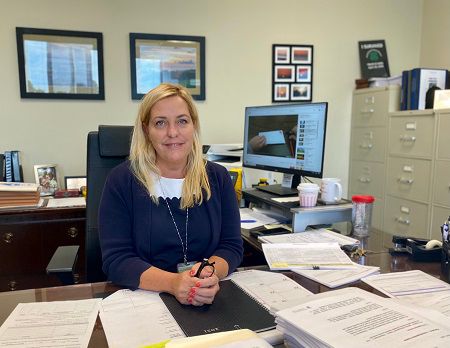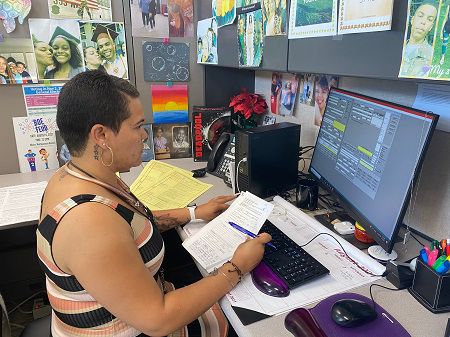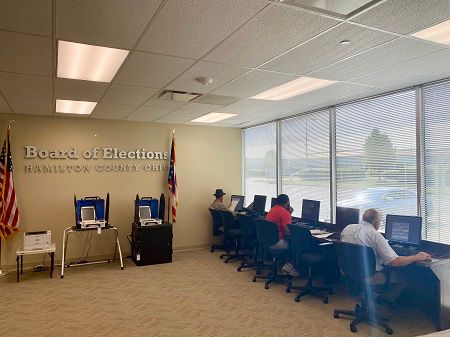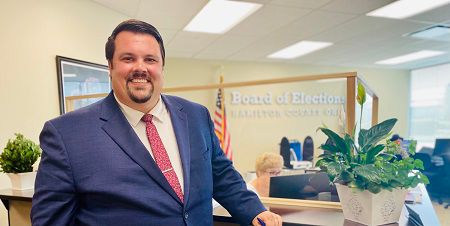CINCINNATI — Getting elected to public office is no small task, but just getting on the ballot can be a major challenge in some instances.
What You Need To Know
- Candidates in political races need to collect 500 signatures to make the ballot in Cincinnati.
- Signatures for Cincinnati races are due Aug. 19.
- COVID-19 has affected strategies for signature collection.
- There’s no pre-review of signatures or petitions, but candidates can use Board of Election kiosks to review signatures
This year, there are 295 positions up for elections across Hamilton County. That includes the mayor of Cincinnati and all nine of the city’s council positions.

Each of those positions has their own rules and processes for getting onto the November ballot. But the first step for most candidates is a trip to the Hamilton County Board of Elections (BOE) in Norwood, Ohio.
BOE Director Sherry Poland said it's especially important for first-time candidates.
"We have staff here who will meet with the candidates when they come to pick up their petition packets, (and) go over some common mistakes that we see candidates make when filling out the forms," Poland said.
In most cases, the only way a would-be candidate can get onto a ballot anywhere in Ohio is to collect a mandated number of signatures from residents willing to nominate them.
To nominate someone, a person must be a registered voter who resides in the jurisdiction where a candidate is running for office. For county-wide positions, that’s anywhere in Hamilton County. For races in townships and cities, the nominators must live within those areas.

“Of course, it's a very important process. It’s how candidates gain access to the ballot and it's how we ensure elections are fair and transparent," said Poland, who has been with the BOE for 17 years. She likes to mark her tenure by saying she’s administered four presidential elections and more than 40 election cycles.
When it comes to elections, there are generally two types of cities in Ohio: statutory cities and charter cities. The distinction determines requirements for making it on the ballot, including the number of signatures needed. Statutory cities have relatively low requirements set by the Ohio Legislature while charter cities, like Cincinnati, use whatever threshold was decided upon by local voters.
In Hamilton County townships, the magic number is 25. The city of Cincinnati requires 500, which is 10 times more than are needed in nearby North College Hill.
"It is a great test run to get used to the campaign," said Pavan Parikh, a local attorney and former judicial candidate. "Because whether you need 50 or 500 signatures, you have to get used to going up to people and asking them for a moment of their time to sign your petition."
It's the job of the Board of Elections to review candidate petitions to ensure those signatures are valid. They'll look at the signature and address to try to match it to a name in the voter registration system. They'll also make sure the other sections of the petitions are filled out correctly. Even a missed section could lead to it being denied.
Roughly 70 candidates pulled petitions for a Cincinnati City Council run, in Southwest Ohio's largest city, meaning they were at least exploring the idea of running.
So far, 28 Cincinnati city council candidates have submitted sufficient signatures and another three are currently in the review process. Seven people have filed petitions BOE staff deemed insufficient, said Alex Linser, the BOE's deputy director.
In 2017, 25 candidates successfully filed and were on the ballot, while nine were left off the ballot due to issues with their petition.
The filing date for that race is 4 p.m. Aug. 19, the same date as races in Madeira and Springdale. Most of the rest of Hamilton County had to file earlier this month.

“You have a lot of first-time candidates, so a lot of people who aren’t used to doing this," Linser said. "You’d be surprised by how many people make simple mistakes on the form — filling out a date wrong, checking the wrong box."
To some, the idea of collecting 500 signatures in a city of 300,000 people may not seem that difficult. But Celeste Treece, a veteran of multiple campaigns, said the process can be "incredibly tedious."
"For instance, you may get a lot of people who want to help you get signatures, but if they aren't a resident of the area where you're running, they can't help," Treece said. "If you're running for a race in Cincinnati and your mom wants to help but she lives in Lincoln Heights, she's not allowed to circulate your petition."
Linser said there is no timeline for when a candidate may start collecting signatures. However, the people who sign the petition have to be registered to vote at the address they put on the petition when the Board of Elections checks it.
The key is finding places with registered voters, not just spots that draw crowds like Findlay Market or outside a Cincinnati Reds game. They may have large crowds but they're likely from a variety of cities, counties and municipalities.

Going to more community-specific events is a better way to engage with campaign volunteers and potential voters, which can help in November, Parikh said. “That person-to-person contact is so critical to being a public official," he explained.
COVID-19 has created a lot of challenges for candidates, Treece said. Things you would do in a normal year — like attending church festivals or just standing outside a grocery store — aren't as routine in this election cycle.
"You need to have strong volunteers who are willing to go out to all these places to collect signatures, that’s a big part,” she said.
The accidental omission of a date or piece of information may not seem like a reason to rule out the entire ballot. But Poland said it’s about presenting accurate information to the potential voters who are nominated a candidate.
"It's important that those forms are accurate because when (a candidate goes) around collecting signatures, the electors who are signing the petition need to have a good understanding of what they’re signing," she said.



